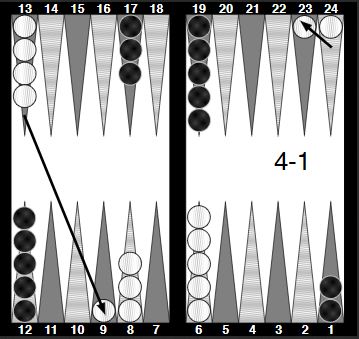Last updated on May 23, 2024
In this Deluxe Backgammon post for beginners, we are going to examine the options for the 4-1 opening move. It certainly isn’t the best opening move, as it doesn’t allow you to secure a new point and with a total of five, it doesn’t do much for the pip count. Many beginners will make the mistake of moving a checker down from the mid-point to the 8-point. This is not an advisable move, because although it is safe, it does nothing for creating a flexible board structure. There are two reasonable ways to play this roll. The first is a relatively low-risk option involving splitting and the second is a more aggressive slotting play.
The two most recommended ways to play this roll are:
24/23, 13/9 (splitting the back checkers and bringing a builder down from the mid-point).
13/9, 6/5 (bringing a builder down and slotting the 5-point).
Another alternative for the 4-1 opening is to slot both of the 5-points. However, this is an extremely risky move. It leaves three blots after the opening move, which provides too many targets for your opponent to ignore.
24/23, 13/9
This is the most popular way of playing an opening 4-1 and the least risky. Splitting your runners increases the chances of securing an advanced anchor early in the game. It also slightly increases the coverage of the opponent’s outer board if they leave blots as they advance. The builder on the 9-point provides additional material and coverage for subsequent rolls. This should provide a good opportunity to secure a point on the next roll. Overall, this is a nicely balanced move with development on both sides of the board.
This is a low-risk move. Splitting early is normally a good option before the opponent’s home board becomes too congested. Also, the blots on the 24 and 23-points, are not likely to be attacked unless they can be hit and covered. If the blots are hit it should be easy to re-enter early in the game. The blot on the 9-point is also relatively safe as it is outside the range of a direct hit.
13/9, 6/5
This slotting play is the more aggressive of the two because your opponent is just as keen to secure the 5-point as you are. A blot on the 5-point will be hit at every opportunity. That said, the time to take risks is early in the game when there is plenty of time to recover. This play is wonderful when it works. The trouble is that your blot on the five-point is exposed to any 4, plus 3-1, double 2, and double 1, while your other blot is exposed to 6-2, 5-3, double 4, and double 2. A double 4 reply from your opponent would result in both checkers hit. Needless to say, having two checkers on the bar at any time is disastrous, particularly against a strong player. That said, a double 4 is only going to occur about 3% of the time.
Computerised rollouts
There is very little between these two plays according to the XG Mobile Backgammon rollouts. The aggressive slotting play is slightly more likely to see the game lost by a gammon, but it is a negligible amount of around 1%. Although not the ideal opening role, the 4-1 should be played based on your own preferences between splitting and slotting.
Related content
Backgammon opening theory at Wikipedia.



I’m a backgammon beginner and it’s probably wrong, but I always play 4-1 safely with 13-8.
Hi George, most backgammon beginners will play that move, but it really isn’t the correct way to play, even though it is safe. The Deluxe Backgammon post on flexibility hopefully should give you a better understanding of how to create more opportunities for yourself. Take note and your backgammon is bound to improve. Thanks for taking the time to comment, Jason.